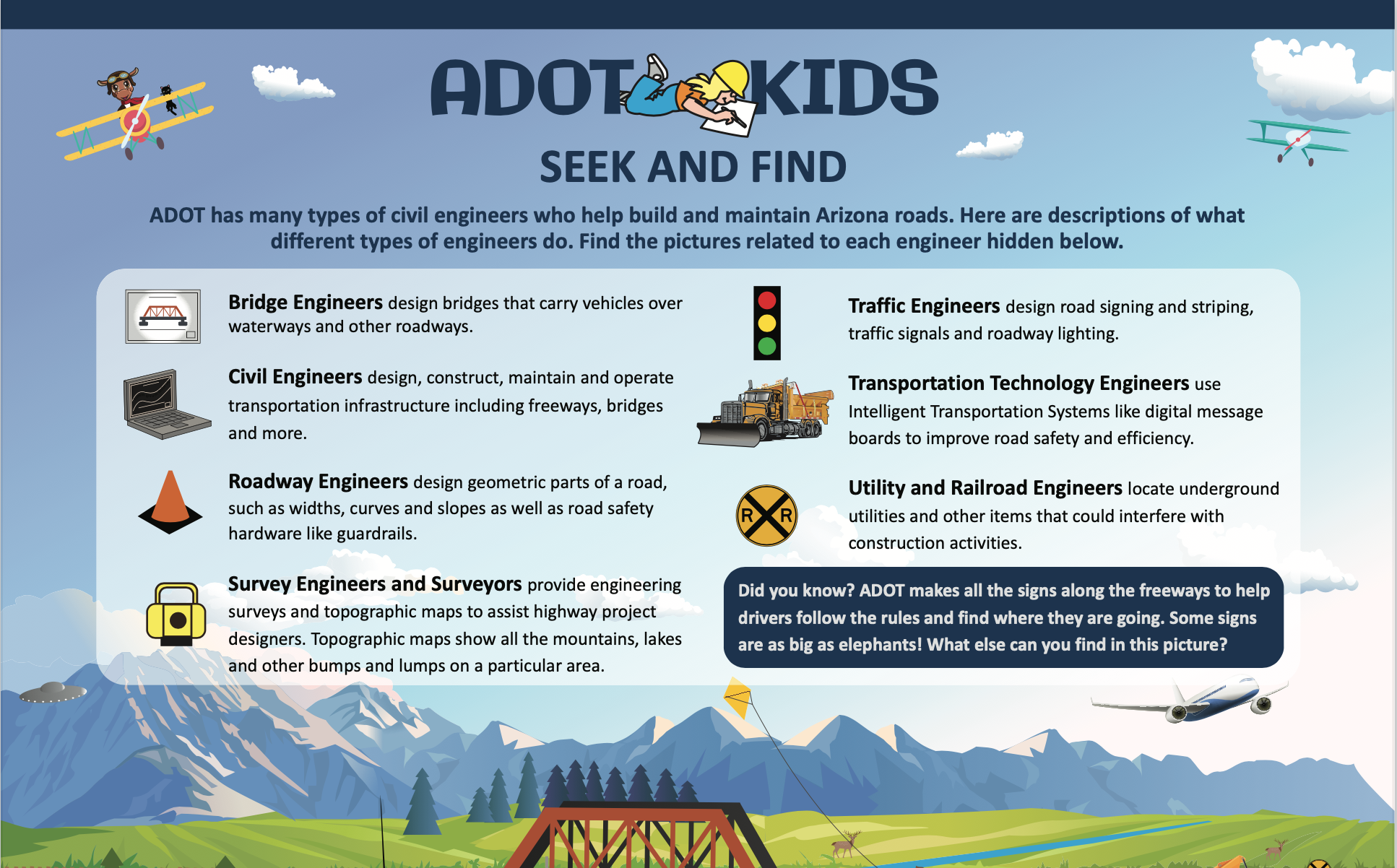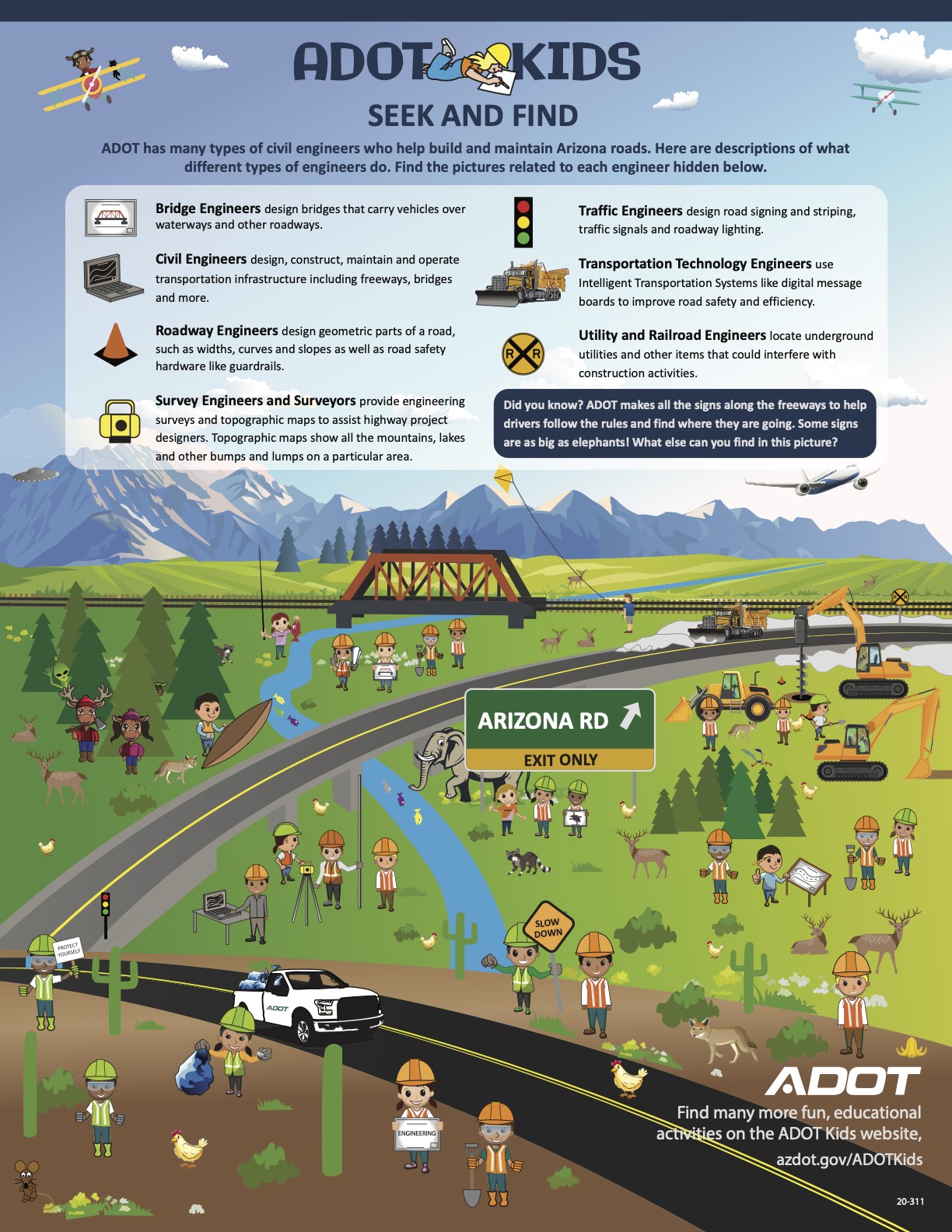ADOT Kids: Here's how to have 'engineer as a career!'
ADOT Kids: Here's how to have 'engineer as a career!'

We love engineers!
But do you know that there are many different types of engineers? Just at ADOT we have many different kinds who look at everything from the best way to get cars over a bridge to the water and power lines that go underground.
If you've ever thought about being an engineer, here are some of the options available to you!
And once you have read about all the different types of engineers, click on the photo to have your parents download our seek-and-find activity to match them with the type of work they do!
Civil Engineers:
If you’ve got the inclination to draw, design, problem solve and create order, you might want to be a civil engineer. Civil engineers uses computer-aided design and drafting to prepare the technical drawings used to build freeways, bridges, and more. Civil engineering deals with the design, construction, and maintenance of the physical and naturally built environment. This includes public works such as roads, bridges, canals, dams, airports, sewage systems, pipelines as well as structural components of buildings and railways.
ADOT has many specific kinds of civil engineers. These include:
- Geotechnical engineers, whose knowledge of soils and rocks are important to building roads and bridges.
- Drainage engineers with expertise in designing for flooding and erosion control.
- Environmental engineers with expertise in minimizing the negative impacts to the environment while constructing and maintaining transportation features.
Civil engineering also includes what we are going to look at next: roadway, traffic and bridge engineers.
Roadway, Bridge and Traffic Engineers:
Roadway, Bridge and Traffic engineers use mathematics and science to determine where or how to build new highways and to make existing highways better.
- Roadway engineers work with many other types of engineers and together they make plans for construction to make the highways. Roadway engineers design the geometric parts of a road such as widths, curves and slopes. They also design road safety hardware like guardrails.
- Bridge engineers use computer programs to design the bridges that carry cars and trucks over waterways, rivers, washes, railroads and other roadways.
- Traffic engineers design the signs, pavement markings and roadway lighting that help make the highways safe to drive on and help people understand where they need to go. They also design traffic control plans used to help traffic move safely through a work zone.
Resident Engineers:
Resident engineers work in ADOT district offices around the state and make sure contractors who build the projects follow the design plans. They also help resolve challenges and find solutions while the project is being constructed.
Survey Engineers and Surveyors:
Before a designer can prepare construction plans for highways, roads and bridges, they need more information about the land they wish to build on.
- Surveyors use tools to measure and locate features like mountains and rivers that can be used to make topographic maps. Topographic maps detail the “topography” of the land, showing the surface of the earth and features such as hills, rivers and houses. These maps and plans help engineers design highways and bridges. Aerial photography is done by planes or drones taking pictures from the sky. Did you know that George Washington was a surveyor?
- Survey engineers and surveyors provide engineering surveys and topographic maps to assist designers of ADOT highway projects. They collect and analyze 3-D information about the land, roads and bridges. They use sophisticated equipment such as Global Positioning Systems (GPS), levels and electronic theodolites. Theodolites are special telescopes that help them measure angles while surveying. They then use computers to make 3-D digital drawings for other engineers to use while designing highways. Survey engineers and surveyors also help ADOT’s Right of Way group by performing property surveys.
Transportation technology engineers:
Transportation technology engineers use computers, electronics, control systems (like traffic lights), communications technologies and management strategies for transportation systems to provide travel information to improve road safety and efficiency. As new transportation technologies emerge, like self-driving vehicles and smart/connected cars, transportation technology engineers are needed to make sure our infrastructure safely accommodates these new transportation trends.
Have you seen the message boards along the freeway? These are types of transportation technology. Technology is also used to calculate the travel times displayed on the boards like how long it will take to get from Phoenix to Tucson based on distance and how fast cars are traveling. If there is a crash on a road and a lane is closed, it will take much longer to get to Tucson from Phoenix.
Utility and railroad engineers:
Utility and railroad engineers work with utility companies and design engineers to locate underground utilities. Did you know that things like the water, electricity and gas that come into your house are called “utilities?” The pipes and wires that bring these utilities are located underground or strung from large poles. Utility engineers help place all these pipes and wires under the ground or on poles.
When highway projects are happening, utility engineers help locate these utilities and other items that could interfere with construction. They use non-invasive technology and techniques along with carefully controlled excavation methods to provide detailed information on underground features so they can either be avoided or relocated. This process is important to construction workers’ safety, controlling costs and making sure people nearby can still have water and electricity.
ADOT does not have engineers that drive trains but they have engineers to determine what to do when a road and a railroad meet at a crossing or when a bridge goes over or under a railroad. To ensure that trains and cars can travel safely while sometimes crossing paths, utility and railroad engineers ensure the safety of motorists and train operators by using signs, signals and pavement markings.
Engineer as a career
There you have it! There are so many different types of engineers you can grow up to be. But all of them are important in designing and building highways and bridges, not to mention keeping people safe.
While deciding what kind of engineer you want to be, have fun with the seek-and-find activity! And if you are really interested in being an "engineer-as-a-career," watch for more ADOT Kids videos, blogs and activities running this week for National Engineers Week. And make sure to check out the ADOT Kids website or find #ADOTKids on social media!

